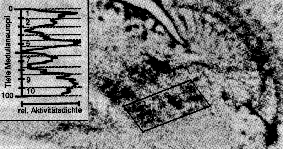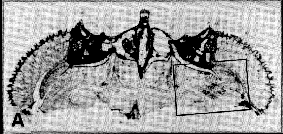 click for magnification
click for magnificationPrinciple of the method: Radioactive 2-deoxyglucose is taken up by active neurons via the glucose transporter, yet not metabolized. Radioactivity accumulates in active cells. Specimen are freeze dried, sectioned and activity is subsequently recorded by autoradiography. Neuronal activity depends on previous stimulus conditions, see example below:
 overview, click for magnification
overview, click for magnificationNote that radioactivity has accumulated on the stimulated side only. Boxed area is enlarged and analysed below.
The two neighbouring visual fields stimulated are clearly reflected in the retinotopic arrays of the optic lobe labelled by 2-deoxyglucose. The boxed area has been used to produce the activity profile shown as insert. Note that layers 1, 5 and 9,10 of the medulla are strongly movement sensitive. Compare 2-deoxyglucose staining pattern with Golgi-shapes of L1- and Mi1-neurons (links will be established).

